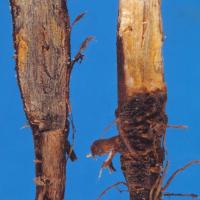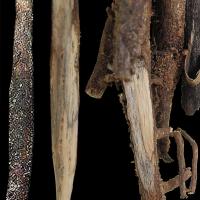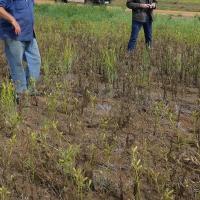Diagnosing charcoal rot in narrow-leafed lupins
Charcoal rot (Macrophomina phaseolina) is a widespread soil-borne fungus but a weak pathogen. It attacks plants that are moisture-stressed late in the season when soil temperatures are warm.
What to look for
- Plants mature prematurely as individual plants or in small groups.
Paddock
- The stem and taproot interior have an ash-grey discolouration, partly caused by masses of tiny black microsclerotia embedded in the tissue.
Plant
What else could it be
| Condition | Similarities | Differences |
|---|---|---|
| Diagnosing spring drought in narrow-leafed lupins | Early plant death | Ash-grey discolouration absent from root interior |
| Diagnosing salinity in narrow-leafed lupins | Early plant death | Ash-grey discolouration absent from root interior |
| Diagnosing hostile subsoil in narrow-leafed lupins | Early plant death | Ash-grey discolouration absent from root interior |
Where did it come from?

Contaminated soil
- M. phaseolina survives as microsclerotia in the soil and on infected plant debris. The microsclerotia serve as the primary source of inoculum and may persist within the soil up to three years.
- It has a wide host range, although cereal species are not normally infected.
Management strategies
- None. Charcoal rot does not usually reduce yields because infection takes place after the plant has completed pod set and the crop is approaching maturity.
See also
Where to go for expert help
Page last updated: Thursday, 16 April 2015 - 4:06pm




